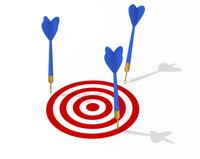Think back on your own schooling, and you'll realize that many classroom environments are meant to stifle failures. If you're currently a student, you well know the embarrassment that comes if you raise your hand and offer an incorrect answer. Students become boxed in, afraid to stretch their thinking beyond the confines that teachers have established. However, research, and anecdotal evidence, is showing that accepting failures as part of the learning process can lead to more creative individuals who are able to apply problem solving skills to new problems.
The December issue of WIRED magazine has a nice article discussing how different research labs approach failures. Turns out the ones that dismiss "bad" data aren't as successful. Stanford psychologist Carol Dweck has an oft-cited book, Mindset, in which she demonstrates how students with "growth" mindsets: those who see failures as challenges and not merely assessments of their intelligence, are more likely to succeed in the long term. Even PBS's show, Design Squad, carries the motto, "Fail fast - succeed sooner!"
How can educators carry this out in the classroom?
Delay Judgment
It's so tempting to immediately shout out, "that's a good idea" or "I don't think that will work". To encourage students to speak up, teachers can delay judgment. In fact, if given the time, students may even figure out their own mistakes. That's far more effective a lesson than teachers saying, "you messed up" at the first error.
Give Frequent Feedback
Daily assessments, or even self-assessments, are more useful than quarterly tests. By practicing the material often, learners are able to gain a deeper understanding. By receiving fast feedback, students can then adapt their learning mid-flow, minimizing big disasters on tests.
Establish Work-cycles
Instead of a linear work flow, teachers can consider work-cycles. Writers and programmers are probably most familiar with this process. Writing a first draft, receiving edits, then going back to rework the draft, then receiving more edits. In this process, learners are continually spiraling towards the final outcome.
Failing Is An Option
February 14, 2010

